JEEP RENEGADE 2018 Owner handbook (in English)
Manufacturer: JEEP, Model Year: 2018, Model line: RENEGADE, Model: JEEP RENEGADE 2018Pages: 356, PDF Size: 6.11 MB
Page 51 of 356
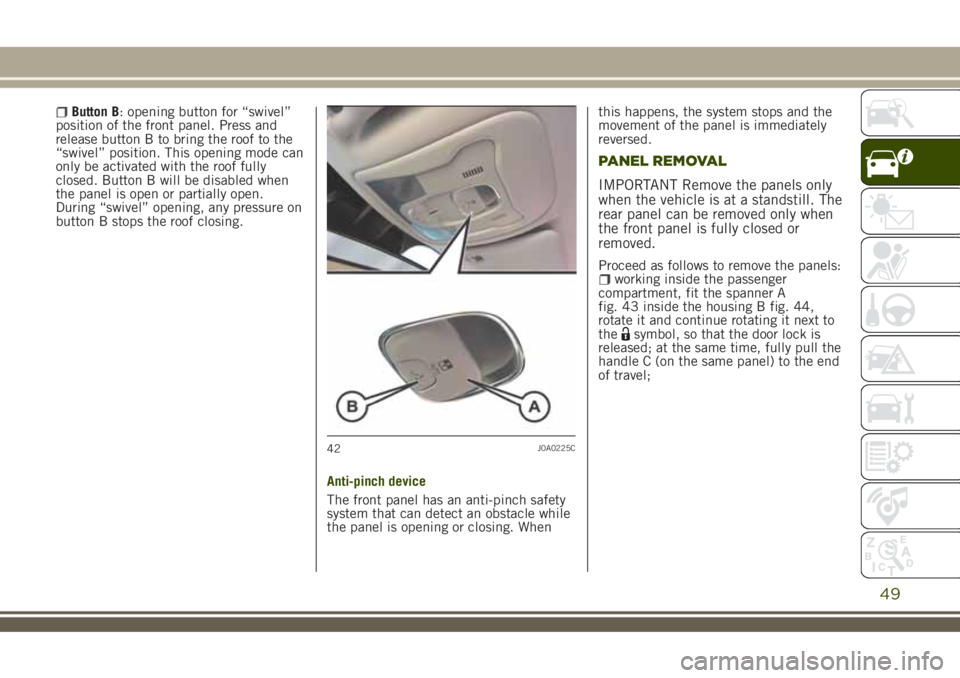
Button B: opening button for “swivel”
position of the front panel. Press and
release button B to bring the roof to the
“swivel” position. This opening mode can
only be activated with the roof fully
closed. Button B will be disabled when
the panel is open or partially open.
During “swivel” opening, any pressure on
button B stops the roof closing.
Anti-pinch device
The front panel has an anti-pinch safety
system that can detect an obstacle while
the panel is opening or closing. Whenthis happens, the system stops and the
movement of the panel is immediately
reversed.
PANEL REMOVAL
IMPORTANT Remove the panels only
when the vehicle is at a standstill. The
rear panel can be removed only when
the front panel is fully closed or
removed.
Proceed as follows to remove the panels:working inside the passenger
compartment, fit the spanner A
fig. 43 inside the housing B fig. 44,
rotate it and continue rotating it next to
the
symbol, so that the door lock is
released; at the same time, fully pull the
handle C (on the same panel) to the end
of travel;
42J0A0225C
49
Page 52 of 356
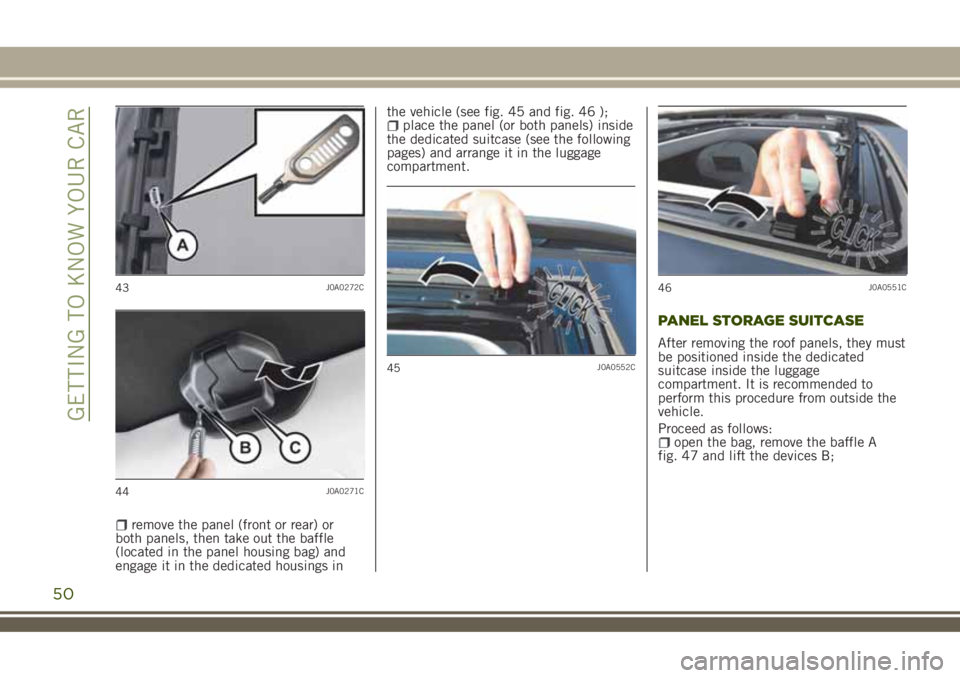
remove the panel (front or rear) or
both panels, then take out the baffle
(located in the panel housing bag) and
engage it in the dedicated housings inthe vehicle (see fig. 45 and fig. 46 );
place the panel (or both panels) inside
the dedicated suitcase (see the following
pages) and arrange it in the luggage
compartment.
PANEL STORAGE SUITCASE
After removing the roof panels, they must
be positioned inside the dedicated
suitcase inside the luggage
compartment. It is recommended to
perform this procedure from outside the
vehicle.
Proceed as follows:
open the bag, remove the baffle A
fig. 47 and lift the devices B;
43J0A0272C
44J0A0271C
45J0A0552C
46J0A0551C
50
GETTING TO KNOW YOUR CAR
Page 53 of 356
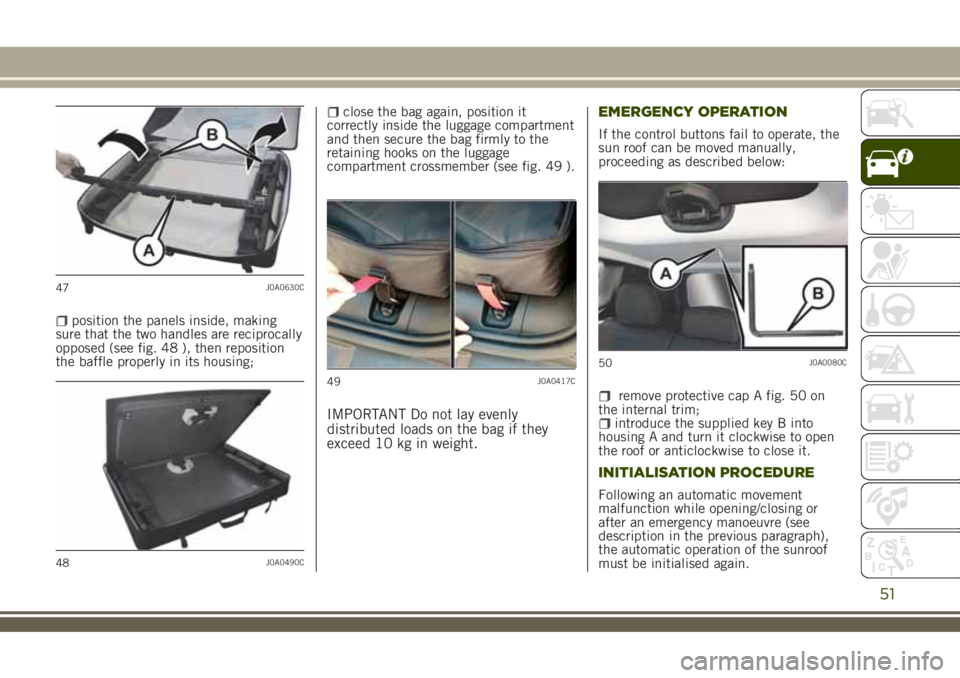
position the panels inside, making
sure that the two handles are reciprocally
opposed (see fig. 48 ), then reposition
the baffle properly in its housing;
close the bag again, position it
correctly inside the luggage compartment
and then secure the bag firmly to the
retaining hooks on the luggage
compartment crossmember (see fig. 49 ).
IMPORTANT Do not lay evenly
distributed loads on the bag if they
exceed 10 kg in weight.EMERGENCY OPERATION
If the control buttons fail to operate, the
sun roof can be moved manually,
proceeding as described below:
remove protective cap A fig. 50 on
the internal trim;
introduce the supplied key B into
housing A and turn it clockwise to open
the roof or anticlockwise to close it.
INITIALISATION PROCEDURE
Following an automatic movement
malfunction while opening/closing or
after an emergency manoeuvre (see
description in the previous paragraph),
the automatic operation of the sunroof
must be initialised again.
47J0A0630C
48J0A0490C
49J0A0417C
50J0A0080C
51
Page 54 of 356
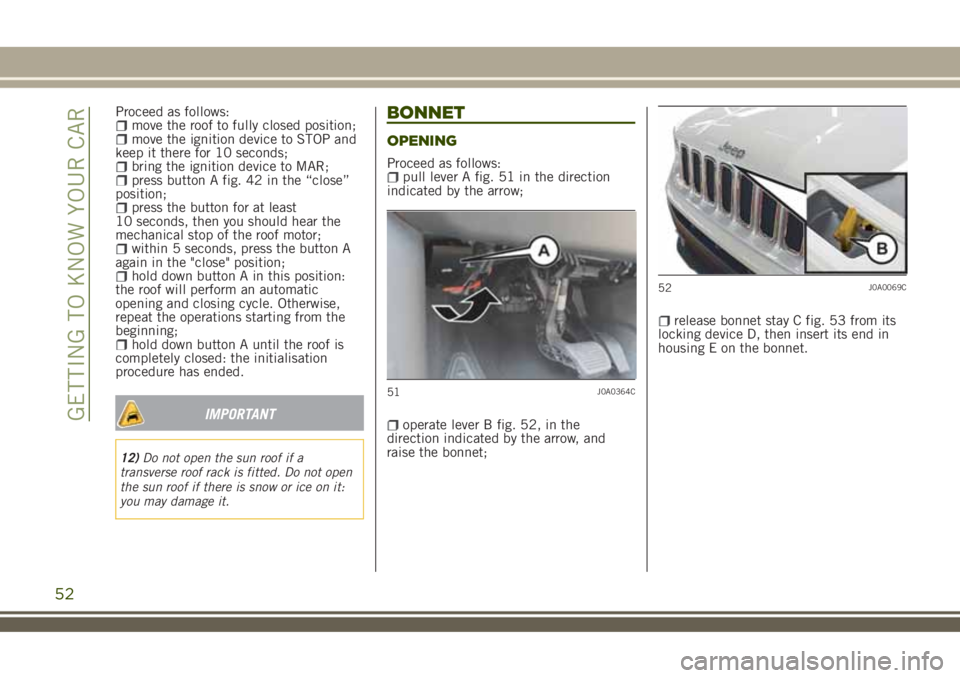
Proceed as follows:move the roof to fully closed position;move the ignition device to STOP and
keep it there for 10 seconds;
bring the ignition device to MAR;press button A fig. 42 in the “close”
position;
press the button for at least
10 seconds, then you should hear the
mechanical stop of the roof motor;
within 5 seconds, press the button A
again in the "close" position;
hold down button A in this position:
the roof will perform an automatic
opening and closing cycle. Otherwise,
repeat the operations starting from the
beginning;
hold down button A until the roof is
completely closed: the initialisation
procedure has ended.
IMPORTANT
12)Do not open the sun roof if a
transverse roof rack is fitted. Do not open
the sun roof if there is snow or ice on it:
you may damage it.
BONNET
OPENING
Proceed as follows:pull lever A fig. 51 in the direction
indicated by the arrow;
operate lever B fig. 52, in the
direction indicated by the arrow, and
raise the bonnet;
release bonnet stay C fig. 53 from its
locking device D, then insert its end in
housing E on the bonnet.
51J0A0364C
52J0A0069C
52
GETTING TO KNOW YOUR CAR
Page 55 of 356
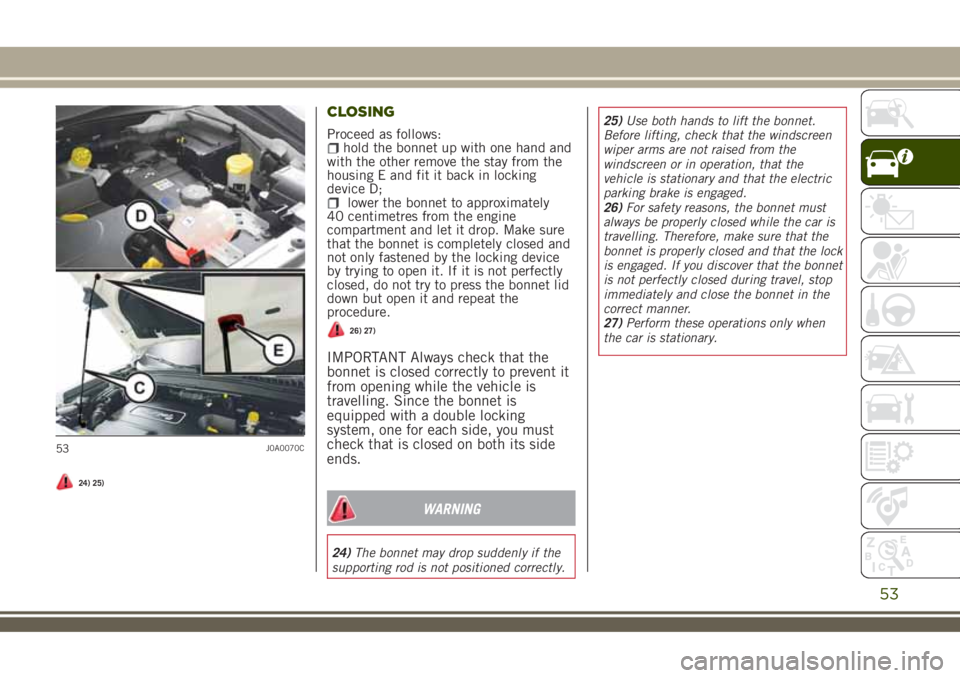
24) 25)
CLOSING
Proceed as follows:hold the bonnet up with one hand and
with the other remove the stay from the
housing E and fit it back in locking
device D;
lower the bonnet to approximately
40 centimetres from the engine
compartment and let it drop. Make sure
that the bonnet is completely closed and
not only fastened by the locking device
by trying to open it. If it is not perfectly
closed, do not try to press the bonnet lid
down but open it and repeat the
procedure.
26) 27)
IMPORTANT Always check that the
bonnet is closed correctly to prevent it
from opening while the vehicle is
travelling. Since the bonnet is
equipped with a double locking
system, one for each side, you must
check that is closed on both its side
ends.
WARNING
24)The bonnet may drop suddenly if the
supporting rod is not positioned correctly.25)Use both hands to lift the bonnet.
Before lifting, check that the windscreen
wiper arms are not raised from the
windscreen or in operation, that the
vehicle is stationary and that the electric
parking brake is engaged.
26)For safety reasons, the bonnet must
always be properly closed while the car is
travelling. Therefore, make sure that the
bonnet is properly closed and that the lock
is engaged. If you discover that the bonnet
is not perfectly closed during travel, stop
immediately and close the bonnet in the
correct manner.
27)Perform these operations only when
the car is stationary.
53J0A0070C
53
Page 56 of 356
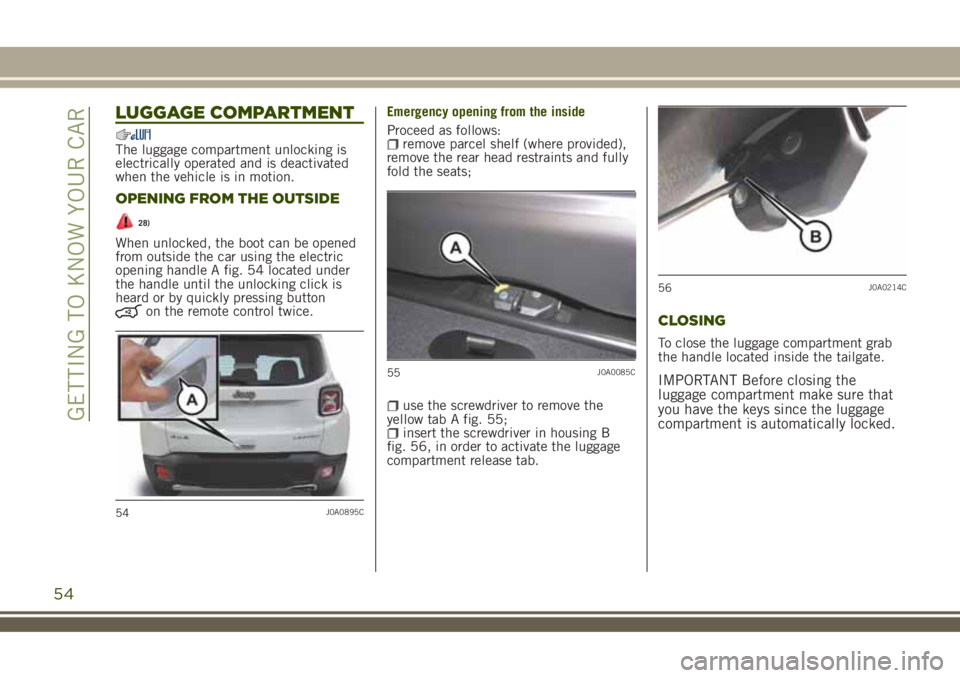
LUGGAGE COMPARTMENT
The luggage compartment unlocking is
electrically operated and is deactivated
when the vehicle is in motion.
OPENING FROM THE OUTSIDE
28)
When unlocked, the boot can be opened
from outside the car using the electric
opening handle A fig. 54 located under
the handle until the unlocking click is
heard or by quickly pressing button
on the remote control twice.Emergency opening from the inside
Proceed as follows:
remove parcel shelf (where provided),
remove the rear head restraints and fully
fold the seats;
use the screwdriver to remove the
yellow tab A fig. 55;
insert the screwdriver in housing B
fig. 56, in order to activate the luggage
compartment release tab.
CLOSING
To close the luggage compartment grab
the handle located inside the tailgate.
IMPORTANT Before closing the
luggage compartment make sure that
you have the keys since the luggage
compartment is automatically locked.
54J0A0895C
55J0A0085C
56J0A0214C
54
GETTING TO KNOW YOUR CAR
Page 57 of 356
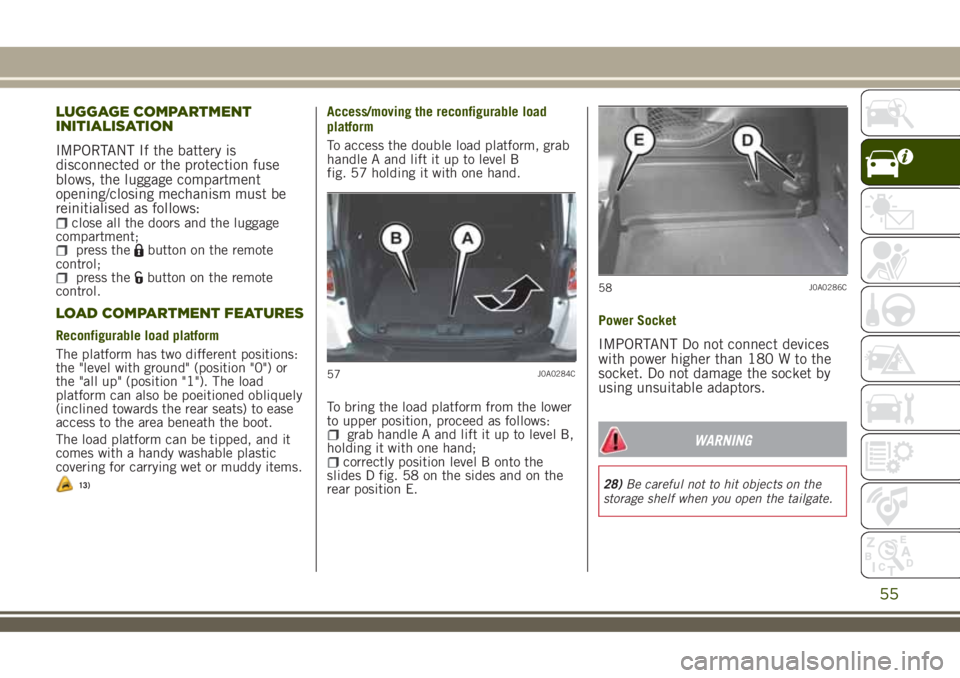
LUGGAGE COMPARTMENT
INITIALISATION
IMPORTANT If the battery is
disconnected or the protection fuse
blows, the luggage compartment
opening/closing mechanism must be
reinitialised as follows:
close all the doors and the luggage
compartment;
press thebutton on the remote
control;
press thebutton on the remote
control.
LOAD COMPARTMENT FEATURES
Reconfigurable load platform
The platform has two different positions:
the "level with ground" (position "0") or
the "all up" (position "1"). The load
platform can also be poeitioned obliquely
(inclined towards the rear seats) to ease
access to the area beneath the boot.
The load platform can be tipped, and it
comes with a handy washable plastic
covering for carrying wet or muddy items.
13)
Access/moving the reconfigurable load
platform
To access the double load platform, grab
handle A and lift it up to level B
fig. 57 holding it with one hand.
To bring the load platform from the lower
to upper position, proceed as follows:
grab handle A and lift it up to level B,
holding it with one hand;
correctly position level B onto the
slides D fig. 58 on the sides and on the
rear position E.Power Socket
IMPORTANT Do not connect devices
with power higher than 180 W to the
socket. Do not damage the socket by
using unsuitable adaptors.
WARNING
28)Be careful not to hit objects on the
storage shelf when you open the tailgate.
57J0A0284C
58J0A0286C
55
Page 58 of 356

IMPORTANT
13)The dimensions of the platform permit
a maximum capacity of distributed weight
of 110 kg on both positions ("0" and "1"):
do not load objects with a higher weight.
VERSION WITH LPG
SYSTEM
(where provided)
29) 30)
14) 15) 16)
INTRODUCTION
The LPG version features two fuel supply
systems: one for petrol and one for LPG.
PASSIVE SAFETY / ACTIVE
SAFETY
Although the LPG system has numerous
safety features, it is advisable to proceed
as follows every time the car is not in use
for a long period or moved in an
emergency as a result of a breakdown or
accident:
unscrew the fixing devices A fig. 59,
then remove the cover B;
close the LPG cock rotating the ring C
refit the cover and retighten the
fastening devices.
59J0A0932C
56
GETTING TO KNOW YOUR CAR
clockwise:
Page 59 of 356
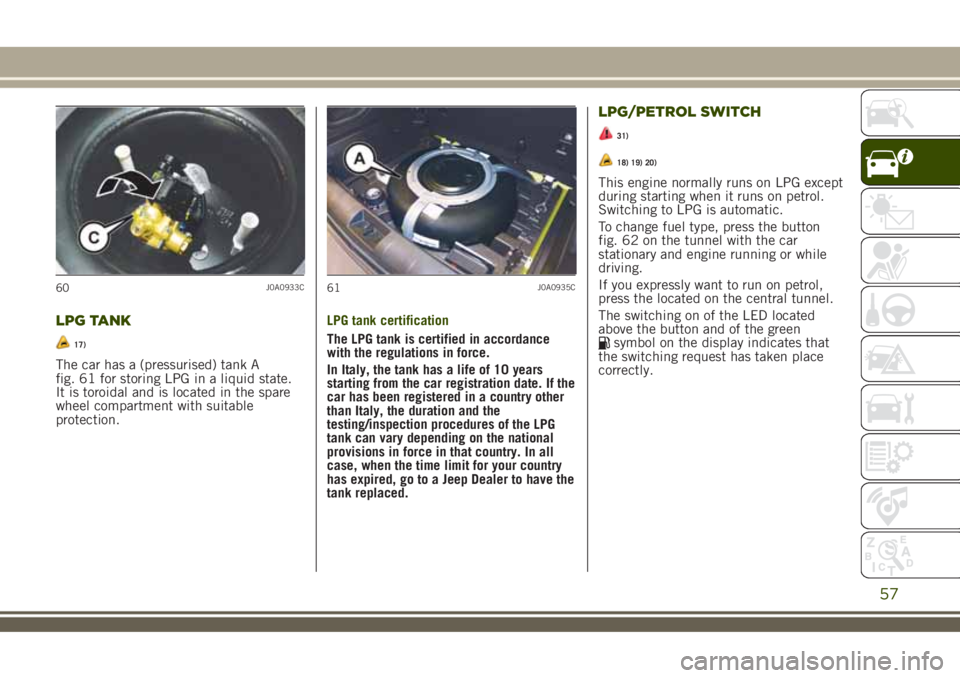
LPG TANK
17)
The car has a (pressurised) tank A
fig. 61 for storing LPG in a liquid state.
It is toroidal and is located in the spare
wheel compartment with suitable
protection.LPG tank certification
The LPG tank is certified in accordance
with the regulations in force.
In Italy, the tank has a life of 10 years
starting from the car registration date. If the
car has been registered in a country other
than Italy, the duration and the
testing/inspection procedures of the LPG
tank can vary depending on the national
provisions in force in that country. In all
case, when the time limit for your country
has expired, go to a Jeep Dealer to have the
tank replaced.
LPG/PETROL SWITCH
31)
18) 19) 20)
This engine normally runs on LPG except
during starting when it runs on petrol.
Switching to LPG is automatic.
To change fuel type, press the button
fig. 62 on the tunnel with the car
stationary and engine running or while
driving.
If you expressly want to run on petrol,
press the located on the central tunnel.
The switching on of the LED located
above the button and of the green
symbol on the display indicates that
the switching request has taken place
correctly.
60J0A0933C61J0A0935C
57
Page 60 of 356
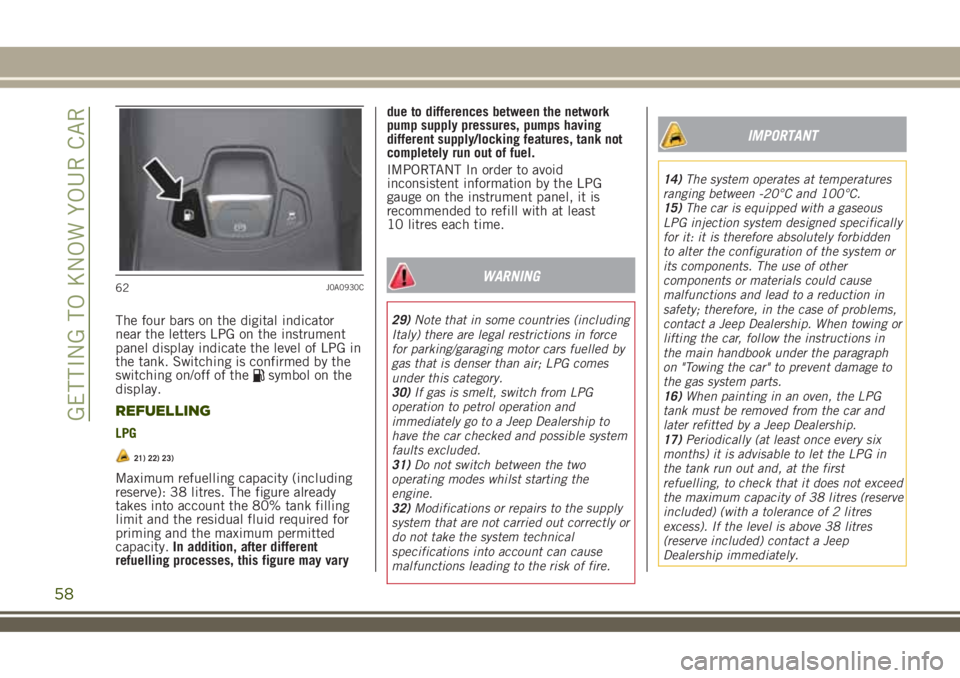
The four bars on the digital indicator
near the letters LPG on the instrument
panel display indicate the level of LPG in
the tank. Switching is confirmed by the
switching on/off of the
symbol on the
display.
REFUELLING
LPG
21) 22) 23)
Maximum refuelling capacity (including
reserve): 38 litres. The figure already
takes into account the 80% tank filling
limit and the residual fluid required for
priming and the maximum permitted
capacity.In addition, after different
refuelling processes, this figure may varydue to differences between the network
pump supply pressures, pumps having
different supply/locking features, tank not
completely run out of fuel.
IMPORTANT In order to avoid
inconsistent information by the LPG
gauge on the instrument panel, it is
recommended to refill with at least
10 litres each time.
WARNING
29)Note that in some countries (including
Italy) there are legal restrictions in force
for parking/garaging motor cars fuelled by
gas that is denser than air; LPG comes
under this category.
30)If gas is smelt, switch from LPG
operation to petrol operation and
immediately go to a Jeep Dealership to
have the car checked and possible system
faults excluded.
31)Do not switch between the two
operating modes whilst starting the
engine.
32)Modifications or repairs to the supply
system that are not carried out correctly or
do not take the system technical
specifications into account can cause
malfunctions leading to the risk of fire.
IMPORTANT
14)The system operates at temperatures
ranging between -20°C and 100°C.
15)The car is equipped with a gaseous
LPG injection system designed specifically
for it: it is therefore absolutely forbidden
to alter the configuration of the system or
its components. The use of other
components or materials could cause
malfunctions and lead to a reduction in
safety; therefore, in the case of problems,
contact a Jeep Dealership. When towing or
lifting the car, follow the instructions in
the main handbook under the paragraph
on "Towing the car" to prevent damage to
the gas system parts.
16)When painting in an oven, the LPG
tank must be removed from the car and
later refitted by a Jeep Dealership.
17)Periodically (at least once every six
months) it is advisable to let the LPG in
the tank run out and, at the first
refuelling, to check that it does not exceed
the maximum capacity of 38 litres (reserve
included) (with a tolerance of 2 litres
excess). If the level is above 38 litres
(reserve included) contact a Jeep
Dealership immediately.
62J0A0930C
58
GETTING TO KNOW YOUR CAR